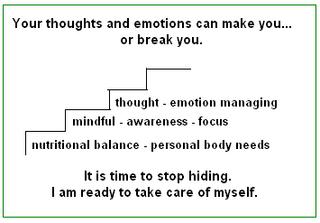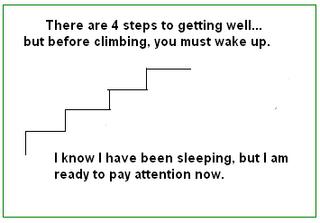
This is another excerpt from my soon to be published book of the same name.
I truly believe that we learn from the stories of others. This is especially true in "Disorderly Eating" or food addiction issues, because so much of it is "secret eating", tightly tied & woven with threads of shame & guilt. As an RN, Clinical Medical Hypnotherapist & disorderly eater, I find myself in the perfect position to tell my truths for the purpose of undressing the problems, while shining the therapeutic light, smack dab in the middle, where healing takes place. My personal & professional experience has taught me that if secrets stay behind closed doors, they cannot be healed. This is one of the biggest reasons why it is so difficult to solve eating issues.
I believe in healing addictions with detachment & humor. Today it's all about cookies & how many cookies it will take to get the child-mind to stop demanding them. Of course, it doesn't have to be cookies; it could be anything that you continually or obsessively think about. Since I've been a disorderly eater for decades, I've been through the gambit; pizza, diet coke, greasy chips, M&M's, chocolate peanut butter ice cream, even strong coffee. Yes, addiction & food obsession has many coats & like with other addictions, manage one & the next one steps up to the plate, in this case, literally. Yes, we would like our eating issues to disappear completely, but it's best to know the truth. Most of them have been harbored from early childhood & are very heavily etched, making it difficult to snuff them out completely. But don't be disheartened. I'm here to tell you that you can learn to play this particular behavioral game well & each time you manage your child-mind, you will become stronger, not only in the area of food, but in others as well. Your self-image, self-esteem & personal power will be built with each & every successful challenge....just like building muscle.
Now, about those cookies. For me, there are cookie-issues, but this particular cookie issue went far beyond the cookie jar. In fact, there was no cookie jar involved. This involved those soft cookies sold in the local supermarkets, to be exact, one chocolate, one chocolate chip & one sugar cookie placed in a bag, not a box. Boxes don't hide well & secrecy was part of the very specific rules & regulations for this binge activity. The cookies were to be purchased on the way home from work, eaten in the car, finished by the time I turned into the subdivision, where I would dutifully stop the car, step out, brush off the crumbs & check my lipstick. I remember one day when my heart raced as a neighbor's car stopped to ask me if I was having a problem. "No problem ...thought there was a wasp in the car." Now lying was added to guilt & shame. I must admit there was a part of me that felt smart & clever as the story was told to the unsuspecting, now deemed ridiculous, nosey neighbor.
Then there came a day when I knew this activity had to stop. I can't remember exactly why; perhaps the angels were trying to save my life again. I loved them & hated them at the same time. As I came to understand more about my internal structure, I could notice my adult/teacher self & then the sassy, child-self who could get out of control on a dime. This day my adult/teacher said "enough." And so, I passed the supermarket with the child-self trying to grab the steering wheel, so I could turn into the parking lot. "Wow...one dangerous child-self!", I thought to myself. She was truly beyond what I had experienced in the past & I remember wondering how far she'd go with me. I've had experiences in the past where I've been afraid of myself, but never with eating or bingeing issues. Just then I remembered I had to pass two other supermarkets. Thinking I had stalled the little beast, I began to relax. "Not so fast", came the violent jolt to my body. "It's not too late. You can still consume them in time." The car actually lurched to the turning lane as if I was possessed or something.
As I pulled the car back, I heard the threats. "I'm make you throw up. You can't stop me. I say what you eat & when you eat it." Now, perhaps you think I'm making this up, but make no mistake. The addictive child-self is without conscience & when she/he senses weakness in the adult/teacher, that is when sparks can fly & in this instance, they were big & they were flying. If she could have pinned me to the wall, she would have done just that. Fortunately, my angel was on my shoulder waking me up. The traffic light turned red & in stillness, I contemplated what had just happened. As I looked to the passenger seat, I could see "her."; about eight years old, pig-tails & a turned down lower lip. "Oh my God, she's really real!! An absolutely dangerous brat & I'm responsible for "her."
For some reason, I remember taking a deep, long meditative breath. This must have been silent angel instructions. Then, I heard my voice; not my usual spitting angry Mother voice that I learned from my own childhood. This was a gentle, but firm, assertive voice that I'd not heard ever before. The red light changed to green & we moved forward. "So tell me. How many cookies is it going to take for you to leave me alone & to never, ever do that again?" Her reply was quiet, but arrogant. "Oh, zillions & gillions." There it was. There would never be enough. Even if I were on my deathbed, she would still be there, in charge & demanding.
The new voice responded, "Well then, that's why you will never, ever have another one of those." Quiet, assertive & very sure. Now, I don't believe in exorcism, but in that moment I felt her presence shift way back into the corner of the car & out of the corner of my eye I noticed she was looking out the window in a relaxed-state. Perhaps she was missing her Mother/Teacher...
Post-script - from that day on there was never, ever a demand or desire for one of those cookies.
~~~~~~~~~~~~~
Copyright 2009 Elizabeth Bohorquez, RN, C.Ht
May not be copied or reproduced without permission of author.
Elizabeth Bohorquez, RN, C.Ht is the author of Sugar...the Hidden Eating Disorder & How to Lick It.










